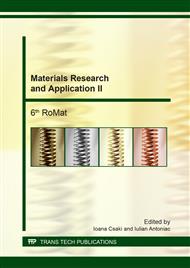p.153
p.159
p.164
p.168
p.175
p.180
p.184
p.189
p.195
New High Entropy Alloy for Biomedical Applications
Abstract:
High Entropy Alloys (HEAs) represent a new concept of metallic materials, that contain 5 or more elements, in proportions from 5 at.% to 35 at.%, and form simple solid solutions (BCC and/or FCC) instead of complicated intermetallic phases. The high degree of randomness atomic HEA, gives them excellent properties: electrical, mechanical, electrochemical, ductility, anti-corrosion properties, stable structure etc, with applications in peak thus representing a growing research. These specific features provides HEA with excellent hardness, strength and wear strength, malleability, oxidation and corrosion resistance, with potential applications in diverse industrial areas [1÷4]. Considering these properties we decide to improve biomedical alloys with this new class of HEAs.
Info:
Periodical:
Pages:
180-183
Citation:
Online since:
August 2017
Authors:
Price:
Сopyright:
© 2017 Trans Tech Publications Ltd. All Rights Reserved
Share:
Citation:


